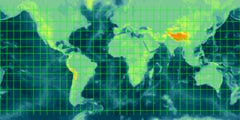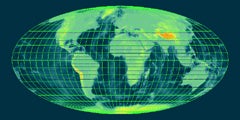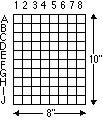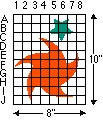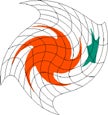| Project C5 |
Transforming Your World |
|||||||
| Objectives |
To explore the differences between size, scale, proportion. To use various measurement tools and transformation techniques as aids to visual expression. |
|||||||
| Project Overview | Your challenge is to plan and execute a composition that illustrates transformation of scale and proportion. | |||||||
|
References for further study
|
1. Richardson, John et al, "Grids, mazes, and modules," Basic Design, Prentice-Hall, pp. 16 - 33, 1984. (optional) 2. Collins, Dan, "Anamorphosis and the Eccentric Observer," Leonardo, Vol. 25 - 26, 1992. (optional) |
|||||||
|
Vocabulary
|
techniques: grids, proportion wheel, scaling by percentages, mapping concepts: size, scale, proportion, ratio, orthogonal, culture/science references: tatami mat, mercator projection, mollweide projection |
|||||||
|
Materials
|
15 x 20" cold press illustration board, your choice of black and white media plus one color or gray. | |||||||
|
Process
|
1. Before coming to class, review the theme of Technology as found on the website. Also read the overview on Scale (UNIT V), taking time to explore the various links. 2. Bring a "found object" to class that has a clear recognizable shape (e.g., a glove), is no smaller than 3" and no larger than 16" in any dimension, and is relatively flat. 3. Using biology paper or tracing paper, create a grid of 1" squares large enough to accommodate your object. Trace the outline of your object onto the grid. 4. Refer to the procedure on the website on entitled "Using Grids for Scale Translation." http://www.asu.edu/cfa/wwwcourses/art/SOACore/scale_scaletrans.htm. 5. If your object is small (2 - 4"), enlarge your object four times its original size (4x) using a grid. If your object is large (12 - 16"), reduce the object to one fourth its original size (1/4x) using a grid. 6. Make a second scale transformation so big that your object is much larger than your board. Choose a fragment at least 15 inches long as an abstract element for your final composition. 6. Now, again referring to the website, alter the grid in different ways. Try altering the proportion of your object by changing the ratio of height to width. Or see what happens to the outline of your object if the grid is compressed into a diamond shape. Try making your "grid" into an irregular system of wavy lines or some other organic, non-regular pattern (hint: keep the same number of units in the x and y axes). 7. Using a representative range of your experiments with altered scale and proportion, create a composition on your 15 x 20" board. (Put ALL of your intitial experiments in your notebook and label them). You may use any medium you like (ink, gouache, art films, etc)--but please limit your palette to three color choices: black, white, and gray (or one other color). You also have a choice of showing the grid or leaving it out. Challenges (optional): Use the computer and/or xerox machine to develop one or more of the images in your composition. (You must use a grid for at least two of your transformations, however). |
|||||||
|
Critique Ideas
|
When you have completed your composition, divide into small groups
and exchange artworks with another group from the class. Within
your group, work together to respond to each project in turn.
Consider the following: 2. Point out any personal and/or cultural symbols the artist used to indicate a particular meaning. 3. Discuss ideas the artwork seems to communicate. After some sharing of interpretations, attempt to state the message of the composition in one sentence. (This artwork is about. . .) 4. Explain how individual shapes, symbols, or other elements of the work support both the overall composition. Look for the effective use of unity principles (UNIT III) and figure/ground relationships (UNIT IV). |
